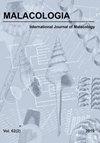印度海岸乌贼属和Loliolus属鱿鱼的形态和分子研究以解决分类歧义
IF 1
4区 生物学
Q4 ZOOLOGY
引用次数: 0
摘要
摘要由于缺乏形态学和分子生物学数据,Lolignidae科近海鱿鱼物种的系统发育关系尚不明确。在本研究中,通过形态学和遗传学分析,阐明了来自印度海岸的鱿鱼种Uroteuthis duvaucelii(Orbigny,1848)、Uroteuthisedulis(Hoyle,1885)、Ureteuthis singhalensis(Ortmann,1891)和Loliolus hardwickei(Gray,1849)的分类地位。这些Uroteuthis物种在不同物种的臂吸盘牙齿上表现出显著差异。触手吸盘齿的锋利度略有增加,顺序为杜氏杜氏杜维杜维杜维杜维杜威杜维杜威杜维杜韦维杜维苏维杜维杜维杜维陶维杜维鲁维杜维维杜维朱维杜维胡维杜维柯维杜维姜维杜维舒维杜维乔维杜维。观察到硬木触手齿的两性异形。根据类似的形状(宽、方形)和数量(5-9)的臂齿推断,辛格哈勒乌罗特乌提斯在形态上与杜氏乌罗特乌提斯非常接近。利用线粒体COI(650bp)、Cyt-b(900bp)和COI-Cyt-b组合基因序列进行贝叶斯系统发育分析,重新确立了Loliolini的单系性概念,并增加了S.singhalensis和L.hardwickei的物种数量。我们重建的系统发育学有力地支持了乌龙属作为一个旁系分类单元,因为所有生物都属于Loliolus属,包括L.hardwickei(亚属:Loliolus)明确归为乌龙属的一个分支。来自印度洋的杜氏乳杆菌和杜氏乳球菌中不同的亚种可能代表着神秘的物种。本文章由计算机程序翻译,如有差异,请以英文原文为准。
Morphological and Molecular Investigations on Squids of the Genera Uroteuthis and Loliolus from the Indian Coast to Resolve Taxonomic Ambiguities
ABSTRACT The phylogenetic relationships of inshore squid species in the family Loliginidae is still ambiguous owing to the lack of morphological and molecular data. In the present study, the taxonomic status of squid species Uroteuthis duvaucelii (Orbigny, 1848), Uroteuthis edulis (Hoyle, 1885), Uroteuthis singhalensis (Ortmann, 1891) and Loliolus hardwickei (Gray, 1849) from the Indian coast was elucidated by performing both morphological and genetic analyses. These Uroteuthis species showed marked differences in arm sucker teeth among species. Sharpness of tentacular sucker teeth was slightly increased in the order U. edulis < U. duvaucelii < U. singhalensis. Sexual dimorphism in tentacular teeth was observed in L. hardwickei. Uroteuthis singhalensis is morphologically very close to U. duvaucelii, as inferred by similar shape (broad, squared) and number (5–9) of arm teeth. Bayesian phylogenetic analysis using mitochondrial COI (650 bp), Cyt b (900bp) and COI-Cyt b combined gene sequences re-established the concept of monophyly of Loliolini with the additional number of species U. singhalensis and L. hardwickei. Our reconstructed phylogeny strongly supports Uroteuthis as a paraphyletic taxon as all organisms belonging to the genus Loliolus, including L. hardwickei (subgenus: Loliolus) explicitly grouped with one of the Uroteuthis clades. Distinct subclades within U. duvaucelii and U. edulis from the Indian Ocean may represent cryptic species.
求助全文
通过发布文献求助,成功后即可免费获取论文全文。
去求助
来源期刊

Malacologia
生物-动物学
CiteScore
2.00
自引率
0.00%
发文量
15
审稿时长
3 months
期刊介绍:
Malacologia publishes papers on all groups of the Mollusca. Malacologia specializes in publishing long papers and monographic treatments. Complete data are especially appreciated. Papers must be of interest to an international readership. Papers in systematics, ecology, population ecology, genetics, molecular genetics, evolution and phylogenetic treatments are especially welcomed. Also welcomed are letters to the editor involving papers published or issues of import to science of the day.
 求助内容:
求助内容: 应助结果提醒方式:
应助结果提醒方式:


